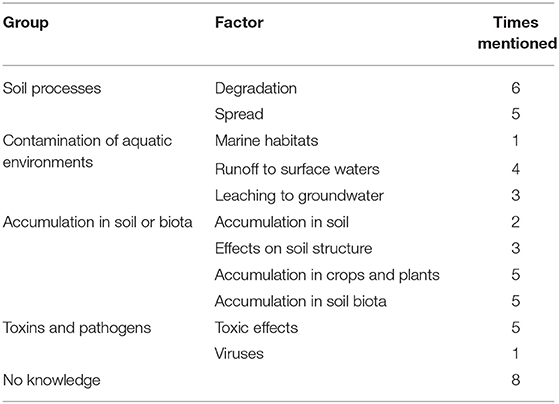Stakeholders' Perspectives on Microplastics in Sludge Applied to Agricultural Land
- Department of Aquatic Sciences and Assessment, Swedish University of Agricultural Sciences Sveriges Lantbruksuniversitet (SLU), Uppsala, Sweden
Microplastic (MPs) inputs to agricultural lands from wastewater and sewage sludge reuse in Europe have been estimated to be between 65,000 and 230,000 tons/year making the farm environment one of the major receptors and, possibly, environmental reservoirs of MPs. In Sweden there have been ongoing discussions since 1994 about environmental and health effects of sewage sludge application to agricultural lands. This debate on sludge use focused initially on metals, then moved on to pharmaceutical residues and currently has turned to MPs. In spite of the limited scientific information about environmental impacts of MPs in soils, governmental approval in Sweden to allow increased spreading of sludge on productive agricultural lands is moving forward. To study individual perceptions of the potential risks, interviews were conducted in 2020 with Swedish stakeholders who in some way work with the issue of sludge management. The results of these interviews provide an indication of not only how environmental risk information is interpreted by representatives from different sectors but also the degree to which perceived risks may shape environmental policy.
Introduction
Microplastics (MPs), or plastic particles smaller than 5 mm, are one of the most discussed environmental issues of the twenty-first century. They were first reported in the Sargasso Sea (Carpenter and Smith, 1972) but it was not until much later that the issue began to attract widespread scientific and popular attention (Thompson et al., 2004). Much of the early focus was on marine systems, but more recently, attention has expanded to include freshwater (Wagner et al., 2014; Eerkes-Medrano et al., 2015; de Sá et al., 2018; Li et al., 2018) and terrestrial environments (Huerta Lwanga et al., 2016; de Souza Machado et al., 2018; Rillig and Lehmann, 2020; Baho et al., 2021). Microplastics are ubiquitous in the environment. They are produced through primary and secondary emission pathways. The former occurs when MPs are introduced directly into the environment via, e.g., domestic and industrial effluents, spills, sewage or indirectly via, e.g., run-off. Secondary MPs emissions are driven by the breakdown of larger plastic particles already present in the environment. Once in the environment, MPs can be further broken down to form nanoplastics (1–100 nm).
The presence of MPs in the terrestrial environment was first reported in 2012 (Rillig, 2012). Terrestrial MPs originate from multiple sources including atmospheric deposition (Allen et al., 2019; Klein and Fischer, 2019), leaching from landfills (He et al., 2019), tire wear (Knight et al., 2020), breakdown of agricultural mulch (Huang et al., 2020; Zhang et al., 2020) and application of sewage sludge to agricultural land (Nizzetto et al., 2016a,b; Crossman et al., 2020). Despite multiple lines of evidence suggesting that terrestrial ecosystems are major MPs sinks, microplastic research in the terrestrial environment is still at an early stage (see, e.g., Baho et al., 2021 for a recent review).
Wastewater treatment plants (WWTPs) typically remove a large fraction of MPs in influent water (Carr et al., 2016). However, they can still be a significant source of MPs to the environment (Murphy et al., 2016; Edo et al., 2020). Multiple studies have documented elevated levels of MPs in receiving waters of WWTPs (e.g., Sun et al., 2019; Schell et al., 2021) as well as in sludge (e.g., Crossman et al., 2020; Edo et al., 2020). When sludge from WWTPs is used either as compost or as a fertilizer for agricultural soils, the MPs removed during wastewater treatment re-enter the environment. Sludge application to agricultural land may add between 63,000–430,000 and 44,000–300,000 tons MPs each year to European and North American farmlands, respectively (Nizzetto et al., 2016b).
The issue of spreading sludge on agricultural land has been actively debated in Sweden over the last 30 years without reaching a definite conclusion (Bengtsson and Tillman, 2004; SOU, 2020:3). Early debates concerned the presence of metals (primarily cadmium) in sludge. This was followed later with new concerns when it was recognized that pharmaceutical residues were also present in sludge. In the last five years the debate has now expanded to include concerns about MPs (Ljung et al., 2018). The primary opposition to spreading with respect to these concerns has come from agricultural producers (Wallenberg and Eksvärd, 2018; Ekane et al., 2021). In response to a lack of guidelines which would ensure that these issues were addressed and that spreading sludge would be accepted by agricultural producers, a national network of WWTPs (Swedish Water) developed a certification program REVAQ in cooperation with the Federation of Swedish farmers (LRF), an agricultural supplier cooperative (Lantmännen) and Swedish grocery chains (L'Ons et al., 2012; Persson et al., 2015). The REVAQ program supplies stakeholders not only with information regarding the composition of REVAQ-certified sludge it also sets guidelines for continuous improvement in the quality of wastewater and sludge with respect to metals and other prioritized substances. However, this voluntary program has not been able to sufficiently resolve the question of whether sewage sludge is deemed to be safe enough to be used as a source of recycled phosphorus (P).
In 2018 the Swedish Government commissioned a study to explore relevant concerns around sludge management with a particular focus on the recycling of P from sludge. In their remit, the committee was assigned several tasks including:
“(to) formulate proposals on the spreading of sewage sludge, with possible exceptions, in order to prevent hazardous substances, pharmaceutical residues and microplastics from entering the ecocycle and to steer toward a non-toxic environment” (SOU, 2020:3, p. 31).
With respect to this question, the committee offered two alternatives:
“ban on spreading of sewage sludge on or in soil through (1) a complete ban on spreading with very limited exceptions, or (2) a ban on spreading on the basis that possible risks are to be managed and addressed—under this option exceptions are permitted for sanitized and quality-assured sludge to be spread on productive farmland” (SOU, 2020:3, p. 32).
While SOU, 2020:3 acknowledged that the presence of MPs had an effect on whether or not sludge spreading should be permitted due to possible risks, the only direct conclusion was that there is a need for more research to determine to what extent MPs have an effect on biota and ecosystems. If the first alternative, a complete ban on spreading, were to be accepted then this would mean that concerns about MPs in sludge would no longer be a high priority for continued research. However, under the second alternative, there is a significant possibility that spreading of sludge, consistent with REVAQ guidelines, would be permitted. Under the current REVAQ guidelines there is no specific analysis required for MPs. On the basis of a study commissioned by the consortium behind the REVAQ program (Ljung et al., 2018), the conclusion was that it was not necessary to establish a threshold value for MPs in their guidelines. Therefore, if the second alternative is adopted by the government, there is a high probability that the sludge will be spread on agricultural land and that this sludge will contain MPs.
Environmental policy is usually informed by scientists but decided on by elected politicians. However, policy is informed not only by opinions from both of these groups but also shaped by input from interested stakeholders. Since the fate of MPs in the environment is a relatively recent area of interest and research, there is a great deal of uncertainty with respect to risks (see, e.g., SAPEA, 2019; Völker et al., 2020; Zhou et al., 2020; Catarino et al., 2021; Thiele and Hudson, 2021) and risk communication (Wardman et al., 2021). To date, there have been a number of studies of stakeholder perspectives and attitudes toward MPs (summarized in Garcia-Vazquez and García-Ael, 2021). Most of these studies have focused on specific groups, e.g. university students (Chang, 2015; Raab and Bogner, 2021) or consumers of personal care products (Anderson et al., 2016) and have targeted MPs impacts on the marine environment.
Thiele and Hudson (2021) conducted an on-line survey on the subject of MPs risks in general with both lay and “topic-experienced” respondents. They found that the topic-experienced group expressed a greater concern than the lay group. They reported that this was not consistent with previous findings that persons with expertise in an area usually assigned a lower risk than the general public (e.g., Persson et al., 2015). Additionally, their survey found that “almost 1/3 of people—including topic-experienced ones—were affirmative about existing evidence or links despite evidence gathered to date suggesting that no proven health effects for humans from microplastics exists.”
Other studies have been conducted on public perceptions of risks associated with MPs. Henderson and Green (2020) conducted focus groups composed of both the general public and people with a special interest or knowledge about MPs. However, as the primary focus of the media has been on MPs in the marine environment, this was the context which respondents used in discussions. Catarino et al. (2021) investigated public perception with respect to the impact of MPs on human health and Deng et al. (2020) wanted to know how willing the public was to take actions to reduce the amount of MPs in the environment.
We are not aware of any studies specifically dedicated to the study of stakeholder perspectives with respect to risks associated with MPs in sludge spread on agricultural soil. However, there have been studies of Swedish stakeholder perspectives on sludge spreading (Bengtsson and Tillman, 2004; Oberg and Mason-Renton, 2018; Ekane et al., 2021).
To better understand Swedish stakeholders' perspectives on the environmental risk from MPs in sludge applied to agricultural soil, in Spring 2020 a survey was planned as part of the IMPASSE research program (Nizzetto et al., 2021). Interviews were designed around the following two central questions:
(i) How much is known with respect to the risk from MPs in terrestrial environments?
(ii) Are MPs a concern when permitting sludge applications to agricultural soil?
Materials and Methods
Stakeholders were first identified based on organizations with an interest in the broad field of sludge management from WWTPs. This identification included politicians, government authorities, sector organizations, interest organizations (environmental NGOs and a farmer association) and research organizations. Based on initial organizational contact, individuals in these organizations were selected for future contact. Finally, when these individuals were contacted some of them suggested including other persons with an interest in the survey. In total 103 stakeholders, representing 37 organizations in Sweden, were contacted and asked to participate. One-third of the contacted individuals, representing twenty-six organizations in five stakeholder categories, agreed to take part in the survey.
The interview protocol was based on our earlier work (Žilinskaite et al., 2021). Interviews were conducted online, using ZOOM and Skype, between late March and early June 2020. Thirty-one interviews were conducted in Swedish and two interviews in English. Each interview lasted between 30 to 90 mins. The limited number of participants allowed the survey to be designed as a series of open-ended questions. The final questionnaire consisted of 25 questions organized into four blocks: MPs in the environment (three questions), contaminants in wastewater sludge (six questions), MPs in agricultural soil (10 questions), sludge regulation and management (six questions). In the following text citations from interviews are presented in italics (the transcriptions and translations from Swedish into English are available on request from the corresponding author).
Interviews were analyzed using Grounded Theory as a qualitative data analysis research design (Creswell, 2013). When using Grounded Theory, the collected data is combined with a qualitative content analysis to generate consistent results based on empirical material (Glaser and Strauss, 2008). The first step consisted in analyzing each interview separately, identifying the stakeholders' main concerns and issues they raised during the interviews. The answers to the questions were then organized in Excel sheets, where each sheet represented one of the five stakeholder categories. Afterwards, the answers were organized into stakeholder categories where each block of questions was analyzed for each one of the five stakeholder categories. Then sub-categories were identified and organized into tables presenting the overall picture by not only stakeholders as a group but also as by stakeholder categories.
In order to better contextualize responses, interviewees were asked to identify their primary area of focus at the beginning of the interview. At this time, stakeholders usually described their current working duties and other relevant projects or tasks they are currently involved with or they have been dealing with in the past. These self-identified focus areas were sorted into seven classifications (Figure 1): sludge management, waste pollutants, pharmaceutical residues, agriculture, waste management, environment and water management. There was considerable overlap between these classifications, e.g., a person with a focus on sludge management would also be likely to have a focus on waste management. However, using the classification did provide a broader picture of the self-identified focus areas for the five stakeholder categories (Figure 1).
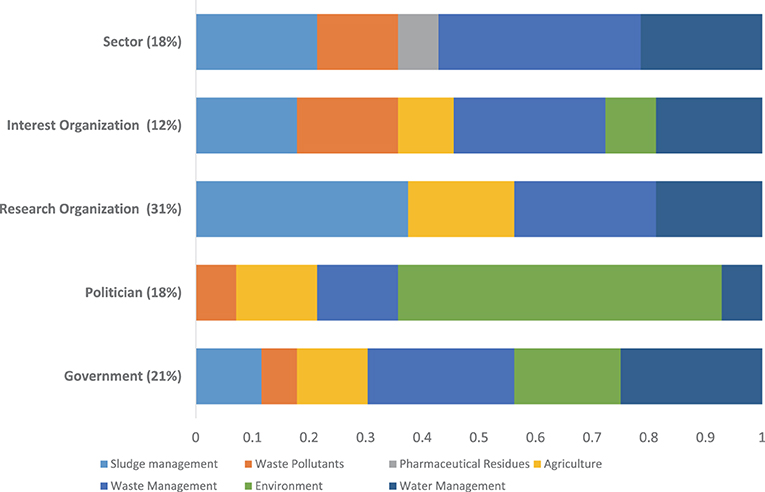
Figure 1. Proportion of stakeholders (n = 31) in each main category and their self-reported primary focus areas.
No stakeholder group identified all seven categories as primary focus areas, but reported between four and six different areas of interest. However, each of the categories, with the exception of public authorities (Government), had one focus area that dominated. Politicians were predominantly focused on the environment which is not surprising as their tasks often include a broader interest. That sludge management was the dominant interest among researchers reflected the fact that individual expertise (research) in that area was a criterion for selection of people to interview. What is more surprising is that no one in this category identified environment as a focus area which also perhaps reflects not only the individuals asked but also a need to focus on a narrow subject as a researcher. Finally, people from both interest and sector organizations identified waste treatment as their major focus area although both groups included additional areas.
Results
In the following sections, each block of questions is represented by one or more central questions. Since the interview format was based on open-ended questions each block had a central theme and the questions included in the block were either central or complementary to the topic area. The complementary questions were included to deepen the responses in order to allow for a more in-depth understanding of each answer when analyzing the results. The complete set of questions is included in the Supplementary Material. In the sections below each block is introduced and then followed by a categorization of the responses to the relevant central questions. The responses were analyzed from two perspectives, as a share of total respondents and as a share within each category. In the text, the share is described as a percentage. For several of the questions responses could be multiple therefore the sum of percentages may be greater than 100%.
MPs in the Environment
The first series of questions related to how stakeholders were affected by the issue of MPs in the environment and their assessment of current scientific and societal knowledge with respect to the presence of MPs in the marine and terrestrial environments. The first central question for stakeholders was “How do MPs issues affect you?.” The responses to this question were distributed across four categories (Figure 2).
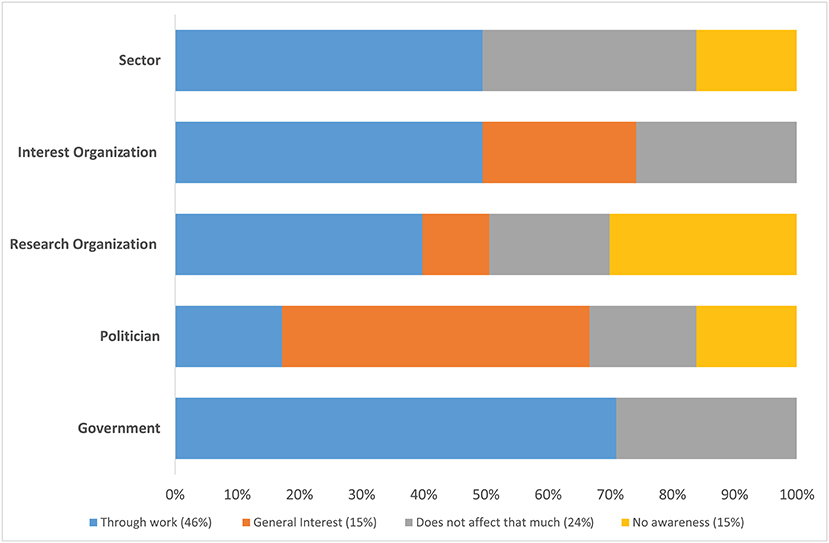
Figure 2. Stakeholder descriptions of how the microplastics issue affects them. Percentages reported represent the frequency with which an issue was mentioned across all stakeholders responding (n = 33).
Almost half (46%) of stakeholders stated that MPs issues affect them directly in their work tasks. An additional 15% expressed that they are in other ways involved in MPs issues, they chose to participate in the interview because of their own general interest in the potential impact of MPs; 24% answered that MPs issues are not a major concern or focus in their work and/or that the issue is not a major focus area for them professionally. The remaining 15% stated that they lacked knowledge on MPs issues. Respondents working in the public sector (Government) answered that they were mainly affected through their work although a small fraction stated that they were not affected that much. Politicians had a greater general interest in MPs issues, with the remaining groups divided evenly between the other possibilities. The greatest share of researchers answered that they were affected daily in their work with only a small number expressing that they had general interest. As noted above, this reflects that a particular group of researchers participated and that as for most researchers they have a narrow research focus on area of expertise. People associated with Interest and Sector organizations were also affected primarily through their work.
The second central question in this series “Why is there so little focus on MPs in the terrestrial environment compared to the marine environment?” was asked to get a sense of why there was divergence in societal interest between the marine and terrestrial environments. Responses are reported separately for the marine (Figure 3) and terrestrial (Figure 4) environments. With respect to MPs in the marine environment, types of explanation were offered (Figure 3). A general belief held by 35% of the stakeholders referred to MPs being harmful for the marine environment, in particular they highlighted the risks that marine mammals ingest MPs or getting stuck in plastic and die. The next largest group, 23%, highlighted that MPs are very visible in the marine environment and therefore get more attention. Another 14% mentioned that in the marine environment it is methodologically easier to measure and collect macro- and MPs. Answers from 10% of the participants stressed the greater political priority the marine environment has while 8% of respondents said that this is a well-known issue and that is why it gets attention continuously. The remaining 8% talked about a possible stronger emotional connection with the marine environment rather than with the terrestrial environment.
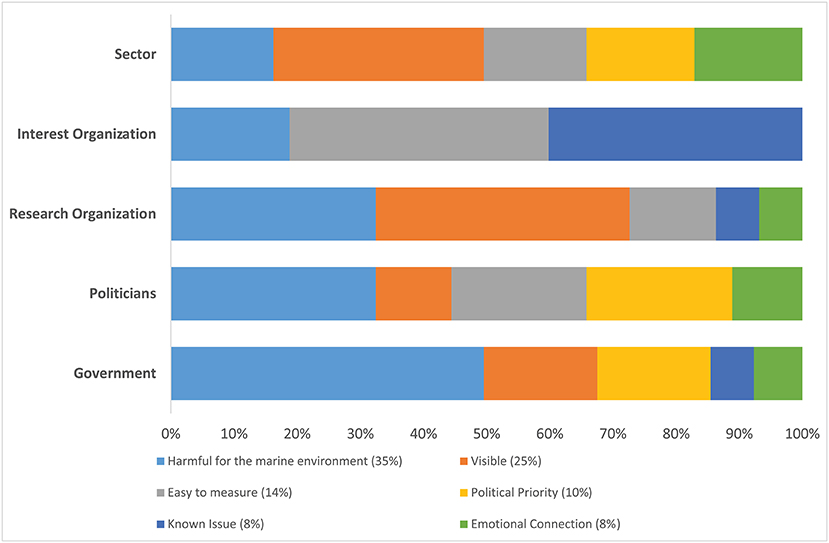
Figure 3. MPs in the marine environment by category of stakeholder. Percentages reported represent the frequency with which an issue was mentioned across all stakeholders responding (n = 46).
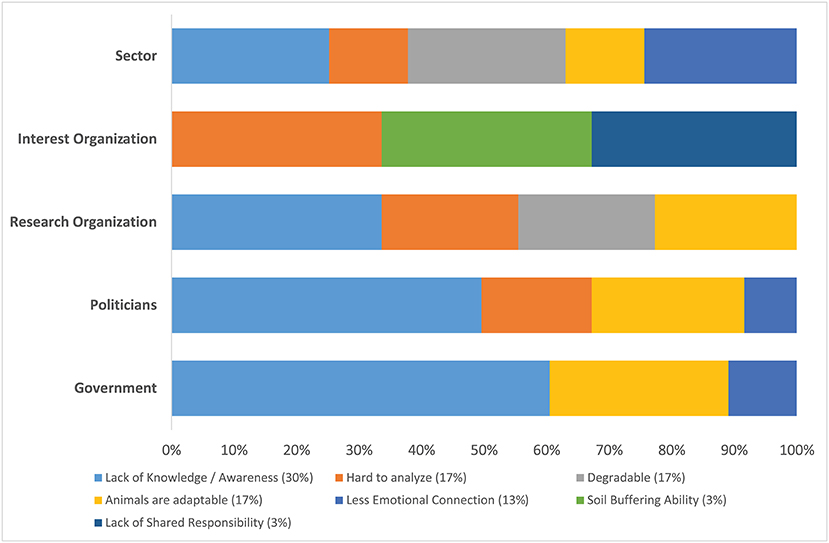
Figure 4. Stakeholder perspectives on MPs in the terrestrial environment. Percentages reported represent the frequency with which an issue was mentioned across all stakeholders responding (n = 28).
Government and politician respondents mainly referred to MPs being harmful for the marine environment, reflecting considerations such as political priorities, visible impacts and the relative ease of measuring and analyzing their impact. Just a small fraction of respondents mentioned that MPs is a known issue and that people may have an emotional connection with the marine environment. A similar small fraction of researchers noted MPs are a known issue and talked about an emotional connection. In general, researchers emphasized the visible impact and the harm MPs are believed to cause to marine life, as well as the ease of measuring and analyzing MPs impacts. Sector respondents reasoned mainly that visible impacts were important, giving the same weight to concerns to political priorities, harm to marine life, emotional connection and the ease of measurement and analysis. Interest organization respondents highlighted that MPs in the marine environment is a known issue and that it is easy to measure and tackle while also being concerned about the harm to marine life.
There were seven main explanations for the lower focus on MPs in the terrestrial environment (Figure 4). Lack of knowledge/research was identified by 30% of the participants as a reason for less interest in MPs in the terrestrial environment. There were also 17% who argued that the lower level of focus might be due to the fact that it is hard to analyze soil environments while another 17% referred to the higher degradation rate of MPs in soils compared to in water. The lower emotional connection to soil than to water was also a reason mentioned by 13% of respondents while another 17% suggested that the lack of focus might be because land animals are better able to adapt to MPs in soils. One respondent referred to the soils buffering ability, or the ability of absorbing nutrients, and another pointed out the lack of shared responsibilities, stating that it is unclear which authorities are responsible for the relevant environmental issues.
Responses from government and politicians both point to a lack of knowledge/awareness as the major reason for a lower interest in the terrestrial environment. This view was shared, though to a lesser degree, by researchers and people in the wastewater sector though both of these also were the only groups who believed that the degradability of MPs in soil may also be an explanation. Respondents from interest organizations differed from the other four categories by being the only group to assigning importance to the buffering ability of the soil and lack of shared responsibilities.
Pollutants in Wastewater Sludge
The second series of questions focused on stakeholder knowledge and perspectives on pollutants present in sludge. The first question was about pollutants in general (Figure 5) while the second question took up how much was known about the presence of MPs in sludge specifically (Figure 6).
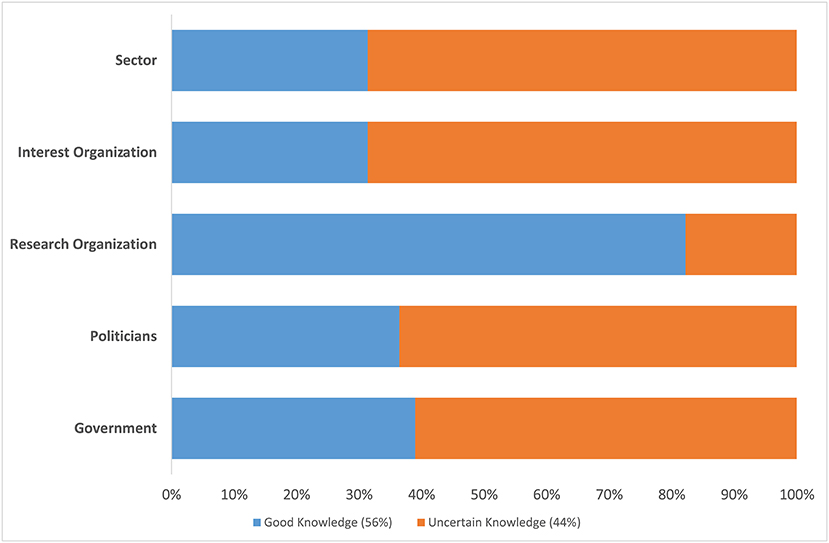
Figure 5. “What is known about pollutants in sludge?” By category of stakeholder. Percentages reported represent the frequency with which an issue was mentioned across all stakeholders responding (n = 22).
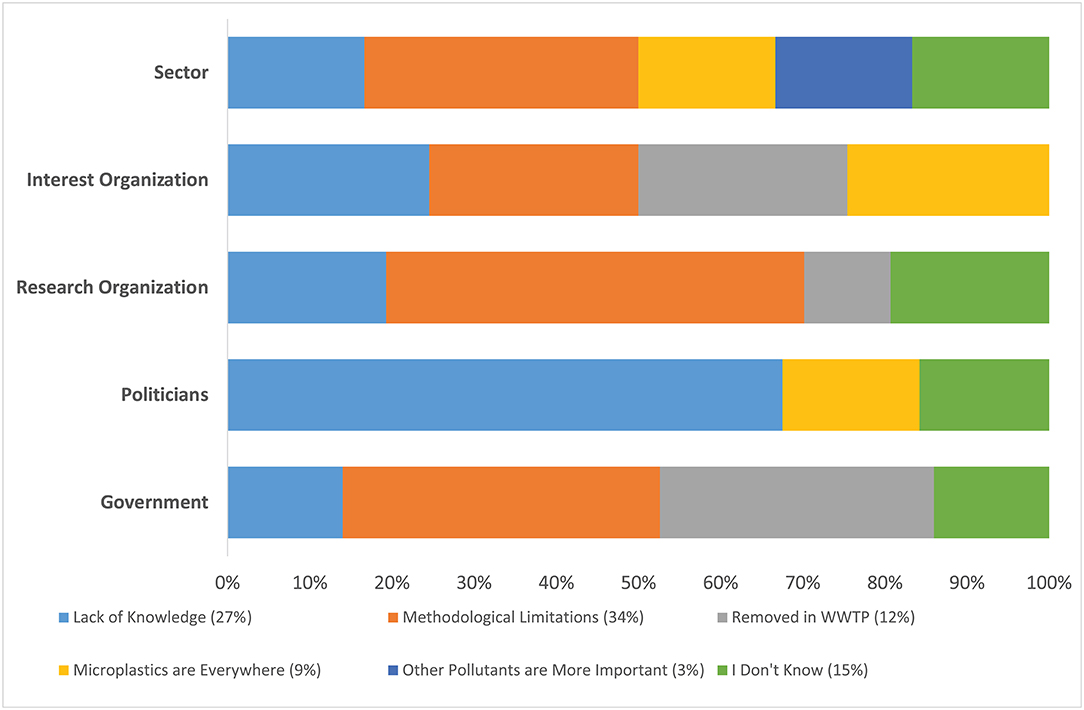
Figure 6. “What is known about MPs in sludge?” By category of stakeholder. Percentages reported represent the frequency with which an issue was mentioned across all stakeholders responding (n = 33).
Responses to the first question “What is known about pollutants in sludge?” were separated into two categories: good knowledge and uncertain knowledge. Over half of the respondents (56%) believed there was good knowledge about pollutants in sludge, primarily because there had been a long-term interest in the spreading of sludge on agricultural land in Sweden and that over a 30 year period there had been many studies related to pollutants in sludge (Figure 5).
The 44% of respondents (14) that were uncertain about the level of knowledge reflected the many unknown and/or new pollutants which add complexity to sludge analysis, with possible cocktail effects. Some in this group specifically referred to the lack of a systematic way to measure pollutants, questioning their limit values and how the different ways in which concentration boundaries are defined. Some of these respondents also argued that sludge composition had changed over time, differing from the product it had been in the past.
Four stakeholder categories were relatively evenly divided, with around half believing that there was good knowledge and half believing there was uncertain knowledge, the researcher category was exceptional as this group expressed the view that the existing knowledge was good. As noted above, since there have been studies performed on pollutants in sludge over a long period of time, these respondents may have believed that the existing knowledge was conclusive and that any effects of changes in sludge composition were not an important factor (Figure 5).
Responses to the second question in this series “What is known about MPs in sludge?” were divided into six categories (Figure 6). Of these, 27% of the interviewees highlighted the general lack of knowledge on the topic while 34% talked about methodological limitations, of which more than half mentioned the lack of standardized methods to detect MPs, noting that MPs analysis in general is not easy and it is harder to do so in sludge. A few interviewees (12%) referred to high removal rates of up to 98% in WWTPs. A small number (10%) noted that MPs are everywhere anyway while one respondent answered that other contaminants might be more important.
Most answers from Government representatives referred to methodological limitations for detecting MPs. Some of them referred to MPs being cleaned by WWTPs and a small fraction referred to the lack of knowledge. Politicians stated that they had a lack of knowledge about MPs in sludge, with some of them specifying they had no notion about it while others mentioned that MPs are anyway present everywhere. Interviewees from research organizations highlighted the methodological limitations in detection and analysis. Some interviewees from this group pointed out the lack of knowledge and the remainder answered they did not know. The distribution of answers from interest organization representatives was split equally between lack of knowledge, methodological limitations, knowing that MPs are cleaned by WWTPs and the notion that MPs are everywhere anyway. Sector representatives mainly talked about the methodological limitations while also highlighting a current lack of knowledge, the notion that MPs are everywhere anyway, the belief that it is more important to evaluate other contaminants and not knowing about MPs.
MPs in Agricultural Soil
The third series of questions specifically addressed stakeholder perceptions of risks associated with sludge spread on agricultural soil. The central question in this series was “How can MPs in sludge affect the environment when applied to agricultural land?.” Responses were categorized into eleven possible environmental risks in five risk groups (Table 1).
The first risk group was associated with possible soil processes including breakdown of MPs into smaller sizes and further transport throughout the soil over time. Multiple respondents thought that MPs would end up in the aquatic environment or accumulate in soil or biota. Possible toxic effects were also mentioned. There were also respondents who claimed not to have any knowledge about possible risks. Although the largest number of respondents were concerned about MPs effects in agricultural lands there was no specific environmental risk which a majority of stakeholders believed to be the most important.
The next question elicited stakeholder views on public awareness, “How aware is the public of MPs in sludge which is applied to agricultural land?.” From the answers it would seem that the general belief is that the public is not very aware of this issue (Figure 7). Only 10% of respondents answered that they thought the public was aware while another 23% considered the public to be somewhat aware. Close to two-thirds of respondents believed the public was not aware. Politicians all held the view that there is a great lack of public awareness. The four other stakeholder categories all indicated that they thought the public was to some degree aware of this issue.
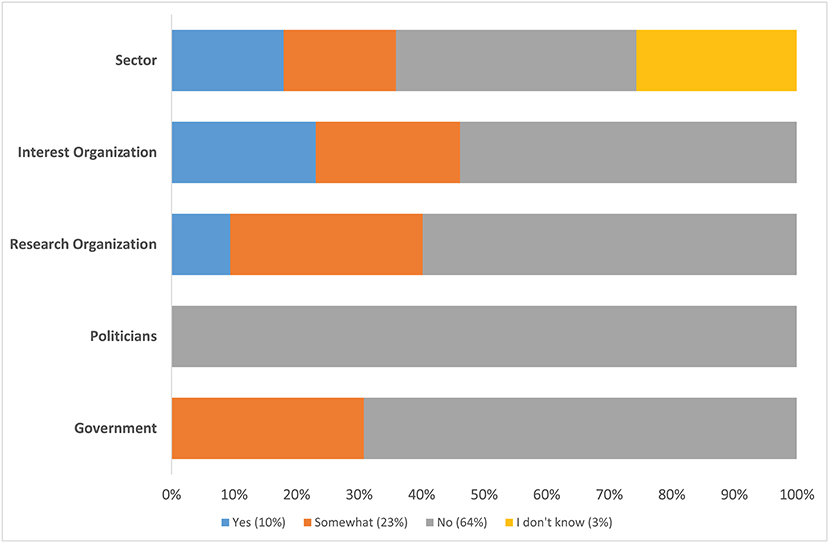
Figure 7. “How aware is the public of MPs in sludge applied to agricultural land?” Percentages reported represent the frequency with which an issue was mentioned across all stakeholders responding (n = 30).
MPs in Sludge Regulation and Management
In the Swedish regulatory environment, guidelines for spreading sludge have existed for more than 30 years. The need for new guidelines has been the subject of a recent national governmental study (SOU, 2020:3). This series of questions focused on stakeholder perceptions of how sludge is managed and regulated. One of the questions in this series asked was “What are the current guidelines for contaminants in sludge?.” Approximately one quarter (24%) of interviewees referred to the existence of guidelines. However, more than half (52%) highlighted that although guidelines exist, they are incomplete while 12% referred specifically to the Swedish certification system REVAQ as an example of upstream work while the remaining 12% said they did not know (Figure 8).
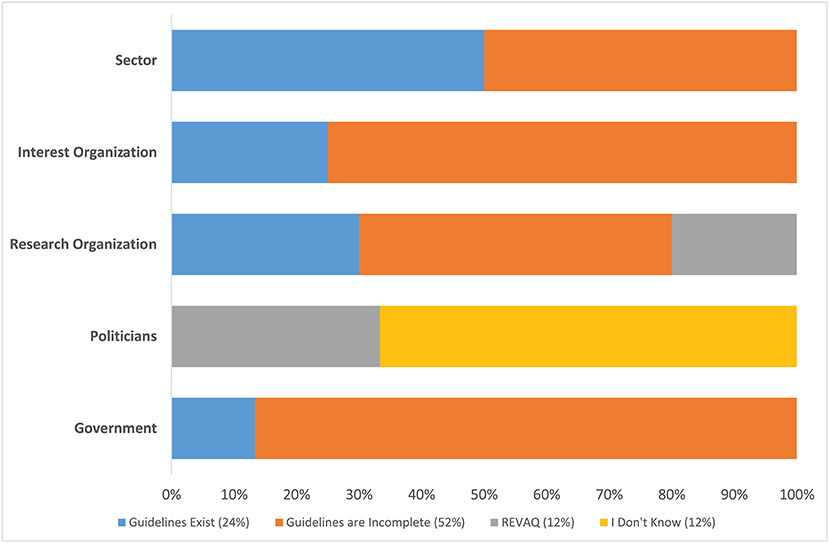
Figure 8. “What are the current guidelines for pollutants in sludge?” Percentages reported represent the frequency with which an issue was mentioned across all stakeholders responding (n = 33).
Government, sector, research and interest organizations participants were all aware of the existence of guidelines but believed them to be incomplete. Stakeholders from research organizations also mentioned the Swedish certification system REVAQ as an example of upstream work and, although most of the politicians answered that they were not aware of existing guidelines, some respondents also referred to the REVAQ certification (Figure 8).
A second core question in this series was what stakeholders thought the issue might look like in the future “How do you think MPs in the sludge will look in 20 years from now?.” The answers were separated into five different categories (Figure 9). Most (66%) thought that in 20 years there would be a minimum use of plastics and that this would lead to less accumulation of MPs. Future research was another area of interest (17%) with respondents believing that the gathering of important knowledge on how plastics and MPs affect humans the environment would take place. A few (7%) answered that other contaminants (e.g., perfluorinated substances) will be seen as more problematic than MPs, while a similar number raised the concern that outdated regulations would not help MPs to vanish from either industrial production or accumulation in the environment. Both those that thought other contaminants were more important and those that were concerned about outdated regulations thought there would be a positive future outcome if the issue of contaminants collected in sludge from WWTPs was addressed with improved systems.
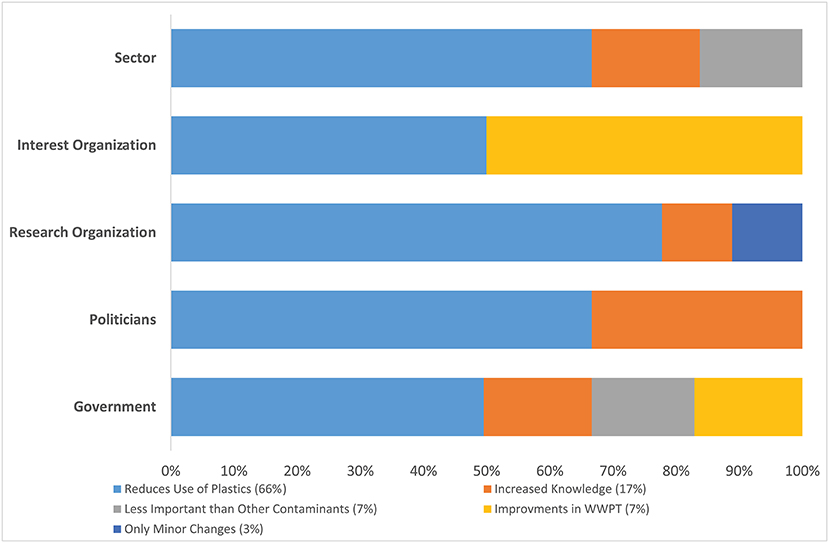
Figure 9. “How do you think MPs in the sludge will look in twenty years from now?” By category of stakeholder. Percentages reported represent the frequency with which an issue was mentioned across all stakeholders responding (n = 29).
Respondents from all stakeholder categories believed that the usage of plastics would diminish in the next 20 years (Figure 9). Participants from interest organizations thought that in the future there would be improvements in systems of management for WWTPs. Politicians thought that in addition to reduced plastic use, there would also be more research into the impacts of MPs on people and the environment. Other sectoral and government stakeholders raised the possibility of other contaminants overshadowing MPs.
Discussion and Conclusions
The purpose of this study was to survey stakeholder perspectives on two questions related to the issue of MPs in sludge spread on agricultural soil in Sweden. Stakeholders were representative of the public sector (politicians and government bodies), branch organizations (primarily associated with wastewater treatment), environmental NGOs and researchers. The most common association with MPs among all those interviewed was through their work (Figure 1).
The first of the two research questions was about respondent's views on their own and the public's level of knowledge with respect to risks connected to MPs in the terrestrial environment. Our results confirm that more attention is currently placed on MPs in the marine environment. Interviewees offered multiple reasons for this focus. The most common reason offered was that MPs are harmful for the marine environment. However, as Thiele and Hudson (2021) note, most information on MPs in the marine environment is likely to have been obtained from media sources that “often deviate from the currently existing scientific knowledge about microplastic pollution.” This view was more prevalent politicians and Government stakeholders. In contrast, the stakeholder categories that work most directly with sludge and MPs (branch organizations and researchers) and that may be expected to have access to more scientific knowledge, believed the main reason for concern about MPs in the marine environment could be attributed to their higher visibility. This higher visibility was not only due to media coverage and an emotional connection “There is a fascination that it should be untouched. The sea should be untouched; you should not destroy” but also because it is easier to find “methodologically, it is easier to collect both ordinary plastic and micro plastics from the aquatic environment1”.
Responses that directly concerned the level of knowledge about MPs in the terrestrial environment did not reveal a clear common thread. Stakeholders were evenly divided between those that believed there was a lack of knowledge or that it was hard to analyze MPs and those that believed that MPs were not really a concern in this environment (Figure 4). This evenly divided belief on the concern about MP impacts was also reflected in opinions about the current state of knowledge with half believing there was good knowledge about pollutants in sludge and half believing that knowledge was uncertain (Figure 9). Although around one-third believed there was too little information available, the remaining answers were evenly divided among four general views, three of which were related to the perceived greater adaptability and buffering capacity of the terrestrial environment: “degradation should be better in soil environments with greater variation in decomposers of organic material” and “there are organisms that are incredibly adapted to disperse in different particles of different shapes.” The fourth view was the difficulty in analyzing MPs in soils. Politicians and government representatives were the groups who felt most strongly that the reason for a lack of interest in MPs was a lack of knowledge or awareness. For these same two group, this finding is similar to the one described above that assigns importance to the role of the media in shaping more interest in MPs in the marine environment.
The second research question which this study focused on was to try and determine if stakeholders were concerned about MPs when permitting sludge applications on agricultural land. Interviewees identified many possible environmental risks but there was no clear consensus on which risk area was most important. Concerning the knowledge of risks associated with pollutants in sludge in general, stakeholder views were split between considering the current knowledge good and considering it to be uncertain. Notably, within the group that would likely have greatest access to scientific studies (i.e. researchers), almost all of the participants perceived the level of knowledge as good. However, with respect to MPs in sludge specifically, knowledge and perceptions on the issue were greatly fragmented. While all groups referred to the lack of knowledge, the most common reason for this was attributed to “methodological limitations.” Surprisingly, for some, in spite of the lack of knowledge, MPs are not a priority “we see other substances that should have higher attention, as PFAS and antibacterial silver where we think we (…) should continue to monitor. But microplastics we do not see that it is the biggest challenge from scientific point of view.”
This lack of consensus about risks associated with MPs in sludge spread on agricultural land is perhaps related to the earlier questions about the level of knowledge and the agreement among respondents that this knowledge needed to be improved. Some of the risks mentioned by respondents indicated that the fate of MPs in soil is still an important open question “there is a possibility of runoff or that they move through macropores in the ground,” “it (MPs) accumulates in the soil and can potentially spread to the recipient,” “spread in the environment, and ends up in the groundwater” and “can accumulate in agricultural land, and are broken down into nanoplastics.”
When asked if they believed society to be aware of the presence of MPs in sludge applied to agricultural land and any associated risks, the most common view expressed was that society is not aware. A smaller fraction of interviewees referred to society being either informed or somewhat informed, with some of its members interested and knowledgeable and others not interested at all.
The last series of questions were designed to elicit stakeholder views about current guidelines and what the issue may look like in the year 2040. Almost all the participants were aware of the existence of regulatory guidelines. It is important to note that more than half of the interviewed stakeholders referred to the existence of incomplete guidelines for managing contaminants in sludge applied to agricultural land (Figure 8). This opinion was reported by all groups except politicians. Politicians and researchers specifically referred to the REVAQ certification system as one of the existing tools to reduce upstream MPs inputs. Finally, when talking about the future of MPs, a few interviewees believed that not much will change and that other contaminants will probably overshadow MPs. Almost all the other stakeholders believed that there will be a reduction in the use of plastics while pointing out that knowledge will be greater and more mature.
In conclusion, while the majority of interviewed Swedish stakeholders believe current national guidelines related to sludge application to agricultural land are incomplete it is not clear that this is based on a concern about MPs. As noted in the introduction, one of the two sludge management alternatives currently under consideration in Sweden would in all likelihood allow sludge with MPs to be spread on agricultural soil. For the stakeholders interviewed in the study the low level of concern about the presence of MPs in sludge may reflect a lack of agreement on a single risk, or set of related risks, which was currently identified as important from an environmental perspective. Respondents' answers about the level of knowledge, ranging from insufficient to good, may be closely related to the general low level of concern. Paradoxically, a belief that there is sufficient knowledge may lead to a low concern based on available evidence just as insufficient knowledge may also lead to a low level of concern based on the lack of evidence. Although stakeholder perceptions of risks associated with MPs in soils was included in the stakeholder survey, the purpose of this study was not to evaluate respondents' judgement of the scientific evidence of specific risks but to focus on if they believed the current level of knowledge was sufficient for decision-making. While there was a recognized need for more research, if MPs are allowed to be spread under new guidelines this research may be no longer on controlled application trials but on observed environmental impacts.
Data Availability Statement
The raw data supporting the conclusions of this article will be made available by the authors, without undue reservation.
Author Contributions
EZ, MF, and DC: conceptualization. EZ: investigation. MF: supervision. EZ and DC: writing—original draft. MF and DC: writing—review and editing. All authors contributed to the article and approved the submitted version.
Funding
This study was financed by FORMAS, the Swedish Research Council for Sustainable Development (contract no. 2017-00029) under the umbrella of the JPI-Water IMPASSE project.
Conflict of Interest
The authors declare that the research was conducted in the absence of any commercial or financial relationships that could be construed as a potential conflict of interest.
Publisher's Note
All claims expressed in this article are solely those of the authors and do not necessarily represent those of their affiliated organizations, or those of the publisher, the editors and the reviewers. Any product that may be evaluated in this article, or claim that may be made by its manufacturer, is not guaranteed or endorsed by the publisher.
Supplementary Material
The Supplementary Material for this article can be found online at: https://www.frontiersin.org/articles/10.3389/fsufs.2022.830637/full#supplementary-material
Footnotes
1. ^All citations in italics in this section are transcriptions and translations from the interviews.
References
Allen, S., Allen, D., Phoenix, V. R., Le Roux, G., Jiménez, P. D., Simonneau, A., et al. (2019). Atmospheric transport and deposition of microplastics in a remote mountain catchment. Nat. Geosci. 12, 339–344. doi: 10.1038/s41561-019-0335-5
Anderson, A. G., Grose, J., Pahl, S., Thompson, R. C., and Wyles, K. J. (2016). Microplastics in personal care products: exploring perceptions of environmentalists, beauticians and students. Marine Pollut. Bull. 113, 454–460. doi: 10.1016/j.marpolbul.2016.10.048
Baho, D. L., Bundschuh, M., and Futter, M. N. (2021). Microplastics in terrestrial ecosystems: moving beyond the state of the art to minimize the risk of ecological surprise. Global Change Biol. 21:1572. doi: 10.1111/gcb.15724
Bengtsson, M., and Tillman, A. M. (2004). Actors and interpretations in an environmental controversy: the Swedish debate on sewage sludge use in agriculture. Resourc. Conserv. Recycl. 42, 65–82. doi: 10.1016/j.resconrec.2004.02.004
Carpenter, E. J., and Smith, K. L. (1972). Plastics on the Sargasso sea surface. Science 175, 1240. doi: 10.1126/science.175.4027.1240
Carr, S. A., Liu, J., and Tesoro, A. G. (2016). Transport and fate of microplastic particles in wastewater treatment plants. Water. 91, 174–182. doi: 10.1016/j.watres.2016.01.002
Catarino, A. I., Kramm, J., Völker, C., Henry, T. B., and Everaert, G. (2021). Risk posed by microplastics: scientific evidence and public perception. Curr. Opin. Green Sustain. Chemistr. 21, 100467. doi: 10.1016/j.cogsc.2021.100467
Chang, M.. (2015). Reducing microplastics from facial exfoliating cleansers in wastewater through treatment versus consumer product decisions. Marine Pollut. Bull. 101, 330–333. doi: 10.1016/j.marpolbul.2015.10.074
Creswell, J. W.. (2013). Qualitative Inquiry and Research Design: Choosing Among Five Approaches. 3rd [updated] edition, Thousand Oaks: SAGE Publications
Crossman, J., Hurley, R. R., Futter, M., and Nizzetto, L. (2020). Transfer and transport of microplastics from biosolids to agricultural soils and the wider environment. Sci. Total Environ. 724, 138334. doi: 10.1016/j.scitotenv.2020.138334
de Sá, L. C., Oliveira, M., Ribeiro, F., Rocha, T. L., and Futter, M. N. (2018). Studies of the effects of microplastics on aquatic organisms: what do we know and where should we focus our efforts in the future? Sci. Total Environ. 645, 1029–1039. doi: 10.1016/j.scitotenv.2018.07.207
de Souza Machado, A. A., Kloas, W., Zarfl, C., Hempel, S., and Rillig, M. C. (2018). Microplastics as an emerging threat to terrestrial ecosystems. Global Change Biol. 24, 1405–1416. doi: 10.1111/gcb.14020
Deng, L., Cai, L., Sun, F., Li, G., and Che, Y. (2020). Public attitudes towards microplastics: Perceptions, behaviors and policy implications. Resour. Conserv. Recycl. 163, 105096. doi: 10.1016/j.resconrec.2020.105096
Edo, C., González-Pleiter, M., Leganés, F., Fernández-Piñas, F., and Rosal, R. (2020). Fate of microplastics in wastewater treatment plants and their environmental dispersion with effluent and sludge. Environ. Pollut. 259, 113837. doi: 10.1016/j.envpol.2019.113837
Eerkes-Medrano, D., Thompson, R. C., and Aldridge, D. C. (2015). Microplastics in freshwater systems: a review of the emerging threats, identification of knowledge gaps and prioritisation of research needs. Water Res. 75, 63–82. doi: 10.1016/j.watres.2015.02.012
Ekane, N., Barquet, K., and Rosemarin, A. (2021). Resources and risks: perceptions on the application of sewage sludge on agricultural land in Sweden, a case study. Front. Sustain. Food Syst. 5, 94. doi: 10.3389/fsufs.2021.647780
Garcia-Vazquez, E., and García-Ael, C. (2021). The invisible enemy. public knowledge of microplastics is needed to face the current microplastics crisis. Sustain. Product. Consumpt. 28, 1076–1089. doi: 10.1016/j.spc.2021.07.032
Glaser, B. G., and Strauss, A. L. (2008). The Discovery of Grounded Theory: Strategies for Qualitative Research. New Brunswick, N.J.: Aldine Transaction
He P. Chen L. Shao L. Zhang H. and L.ü, F. (2019). Municipal solid waste (MSW) landfill: a source of microplastics?-evidence of microplastics in landfill leachate. Water Res. 159, 38–45. doi: 10.1016/j.watres.2019.04.060
Henderson, L., and Green, C. (2020). Making sense of microplastics? Public understandings of plastic pollution. Mar. Pollut. Bull. 152, 110908. doi: 10.1016/j.marpolbul.2020.110908
Huang, Y., Liu, Q., Jia, W., Yan, C., and Wang, J. (2020). Agricultural plastic mulching as a source of microplastics in the terrestrial environment. Environ. Pollut. 260, 114096. doi: 10.1016/j.envpol.2020.114096
Huerta Lwanga, E., Gertsen, H., Gooren, H., Peters, P., Salanki, T., van der Ploeg, M., et al. (2016). Microplastics in the Terrestrial Ecosystem: Implications for Lumbricus terrestris (Oligochaeta, Lumbricidae). Environ. Sci. Technol. 50, 2685–2691. doi: 10.1021/acs.est.5b05478
Klein, M., and Fischer, E. K. (2019). Microplastic abundance in atmospheric deposition within the Metropolitan area of Hamburg, Germany. Sci. Total Environ. 685, 96–103. doi: 10.1016/j.scitotenv.2019.05.405
Knight, L. J., Parker-Jurd, F. N., Al-Sid-Cheikh, M., and Thompson, R. C. (2020). Tyre wear particles: an abundant yet widely unreported microplastic? Environ. Sci. Pollut. Res. 27, 18345–11835. doi: 10.1007/s11356-020-08187-4
Li, J., Liu, H., and Chen, J. P. (2018). Microplastics in freshwater systems: a review on occurrence, environmental effects, and methods for microplastics detection. Water Res. 137, 362–374. doi: 10.1016/j.watres.2017.12.056
Ljung, E., Olesen, K. B., Andersson, P. G., Fältström, E., Vollertsen, J., Wittgren, H. B., et al. (2018). Mikroplaster i kretsloppet. Svenskt Vatten Utveckling Rapport, Nr, p. 13.
L'Ons, D. I., Mattsson, A., Davidsson, F., and Mattsson, J. (2012). “REVAQ-the Swedish certification system for sludge application to land-Experiences at the Rya WWTP in Gothenburg and challenges for the future,” in Proceedings of 17th European Biosolids & Organic Resources Conference, ed N. J. Horn (Leeds: AquaEnviro), 1-12. Available online at: https://conferences.aquaenviro.co.uk/wp-content/uploads/sites/7/2015/07/6-IOns-D.-Gryaab-AB.pdf
Murphy, F., Ewins, C., Carbonnier, F., and Quinn, B. (2016). Wastewater treatment works (WwTW) as a source of microplastics in the aquatic environment. Environ. Sci. Technol. 50, 5800–5808. doi: 10.1021/acs.est.5b05416
Nizzetto, L., Andreu, R., Van Gestel, K., Selonen, S., Crossman, J., Futter, M., et al. (2021). IMPASSE–Impacts of microplastic in agrosystems and stream environments. NIVA-rapport 7632.
Nizzetto, L., Futter, M., and Langaas, S. (2016a). Are agricultural soils dumps for microplastics of urban origin? Environ. Sci. Technol. 50, 10777–10779. doi: 10.1021/acs.est.6b04140
Nizzetto, L., Langaas, S., and Futter, M. (2016b). Pollution: do microplastics spill on to farm soils? Nature 537, 488–488. doi: 10.1038/537488b
Oberg, G., and Mason-Renton, S. A. (2018). On the limitation of evidence-based policy: regulatory narratives and land application of biosolids/sewage sludge in BC, Canada and Sweden. Environ. Sci. Policy 84, 88–96. doi: 10.1016/j.envsci.2018.03.006
Persson, T., Svensson, M., and Finnson, A. (2015). Revaq certified wastewater treatment plants in Sweden for improved quality of recycled digestate nutrients. IEA Bioenergy Task 37, 4. Available online at: https://www.ieabioenergy.com/wp-content/uploads/2018/01/REVAQ_CAse_study_A4_1.pdf
Raab, P., and Bogner, F. X. (2021). Conceptions of university students on microplastics in Germany. PLOS ONE 16, e0257734. doi: 10.1371/journal.pone.0257734
Rillig, M. C.. (2012). Microplastic in terrestrial ecosystems and the soil? Environ. Sci. Technol. 46, 6453–6454. doi: 10.1021/es302011r
Rillig, M. C., and Lehmann, A. (2020). Microplastic in terrestrial ecosystems. Science 368, 1430. doi: 10.1126/science.abb5979
SAPEA (2019). Scientific Perspective on Microplastics in Nature and Society. Berlin: Science Advice for Policy by European Academies.
Schell, T., Hurley, R., Nizzetto, L., Rico, A., and Vighi, M. (2021). Spatio-temporal distribution of microplastics in a Mediterranean river catchment: the importance of wastewater as an environmental pathway. J. Hazardous Mater. 21, 126481. doi: 10.1016/j.jhazmat.2021.126481
SOU (2020). “Sustainable Sludge Management (Hållbar slamhantering). SOU 2020:3 2020, Stockholm: Ministry of the Environment,” in Swedish with English summary. ISBN 978-91-38-25017-4
Sun, J., Dai, X., Wang, Q., van Loosdrecht, M. C., and Ni, B. J. (2019). Microplastics in wastewater treatment plants: detection, occurrence and removal. Water Res. 152, 21–37. doi: 10.1016/j.watres.2018.12.050
Thiele, C. J., and Hudson, M. D. (2021). Uncertainty about the risks associated with microplastics among lay and topic-experienced respondents. Scientific Rep. 11, 1–9. doi: 10.1038/s41598-021-86569-5
Thompson, R. C., Olsen, Y., Mitchell, R. P., Davis, A., Rowland, S. J., John, A. W. G., et al. (2004). Lost at sea: where is all the plastic? Science 304, 838–838. doi: 10.1126/science.1094559
Völker, C., Kramm, J., and Wagner, M. (2020). On the creation of risk: framing of microplastics risks in science and media. Glob. Challenges 4, 1900010. doi: 10.1002/gch2.201900010
Wagner, M., Scherer, C., Alvarez-Muñoz, D., Brennholt, N., Bourrain, X., Buchinger, S., et al. (2014). Microplastics in freshwater ecosystems: what we know and what we need to know. Environ. Sci. Europe 26, 1–9. doi: 10.1186/s12302-014-0012-7
Wallenberg, P., and Eksvärd, J. (2018). Lantbrukets syn på kretslopp. Stockholm: MAt i Cirkulära Robusta (MACRO) system.
Wardman, T., Koelmans, A. A., Whyte, J., and Pahl, S. (2021). Communicating the absence of evidence for microplastics risk: balancing sensation and reflection. Environ. Int. 150, 106116. doi: 10.1016/j.envint.2020.106116
Zhang, D., Ng, E. L., Hu, W., Wang, H., Galaviz, P., Yang, H., et al. (2020). Plastic pollution in croplands threatens long-term food security. Global Change Biol. 26, 3356–3367. doi: 10.1111/gcb.15043
Zhou, Y., Wang, J., Zou, M., Jia, Z., Zhou, S., and Li, Y. (2020). Microplastics in soils: a review of methods, occurrence, fate, transport, ecological and environmental risks. Sci. Total Environ. 748, 141368. doi: 10.1016/j.scitotenv.2020.141368
Keywords: agricultural soil, circular economy, MPs, sewage sludge, stakeholder interviews/analysis
Citation: Zilinskaite E, Futter M and Collentine D (2022) Stakeholders' Perspectives on Microplastics in Sludge Applied to Agricultural Land. Front. Sustain. Food Syst. 6:830637. doi: 10.3389/fsufs.2022.830637
Received: 07 December 2021; Accepted: 13 January 2022;
Published: 21 February 2022.
Edited by:
Paula Alvarenga, University of Lisbon, PortugalReviewed by:
Nicolas Beriot, Wageningen University and Research, NetherlandsJuan José Alava, University of British Columbia, Canada
Copyright © 2022 Zilinskaite, Futter and Collentine. This is an open-access article distributed under the terms of the Creative Commons Attribution License (CC BY). The use, distribution or reproduction in other forums is permitted, provided the original author(s) and the copyright owner(s) are credited and that the original publication in this journal is cited, in accordance with accepted academic practice. No use, distribution or reproduction is permitted which does not comply with these terms.
*Correspondence: Dennis Collentine, dennis.collentine@slu.se
 Emilija Zilinskaite
Emilija Zilinskaite  Martyn Futter
Martyn Futter Dennis Collentine
Dennis Collentine